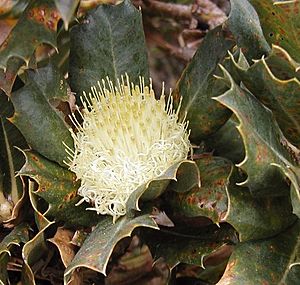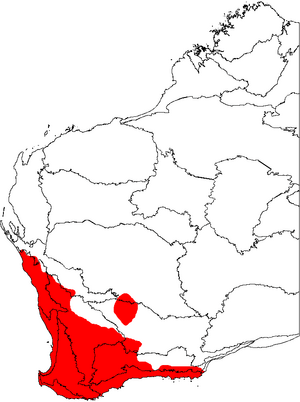Banksia ser. Dryandra facts for kids
Quick facts for kids Banksia ser. Dryandra |
|
|---|---|
 |
|
| Inflorescence of B. sessilis (Parrotbush), Cape Naturaliste | |
| Scientific classification |
|
| Kingdom: | Plantae |
| Clade: | Tracheophytes |
| Clade: | Angiosperms |
| Clade: | Eudicots |
| Order: | Proteales |
| Family: | Proteaceae |
| Genus: | Banksia |
| Subgenus: | Banksia subg. Banksia |
| Series: | Banksia ser. Dryandra (R.Br.) A.R.Mast & K.R.Thiele |
| Species | |
|
92, see list |
|
Banksia ser. Dryandra is a group of 94 types of shrubs and small trees that belong to the plant genus Banksia. These plants used to be called a separate group named Dryandra until early 2007. Scientists decided to combine them with Banksia because new studies showed they were very closely related.
You can only find these plants in the southwestern part of Western Australia. They are not very popular with gardeners in other parts of Australia. This is because they don't like the wet and humid weather often found on the east coast.
The group was named to honor a Swedish botanist named Jonas C. Dryander. Many people think these plants are some of the most beautiful and colorful in their plant family, Proteaceae.
The young forms (called larvae) of some Lepidoptera species, like the Dryandra moth, eat Banksia ser. Dryandra plants.
Discovering Banksia ser. Dryandra Plants
The very first examples of a Dryandra plant were collected by Archibald Menzies. He was a surgeon and a naturalist on the Vancouver Expedition in 1791. Joseph Banks, a famous scientist, asked Menzies to collect plants and animals wherever he could during the trip.
In September and October 1791, the expedition stopped at King George Sound. There, Menzies collected many plant samples. These included the first samples of B. sessilis (Parrotbush) and B. pellaeifolia. When Menzies returned to England, he gave his samples to Banks. However, like many other samples, they were not officially described for many years.
More plants were collected in late 1792 by Jacques Labillardière. He was one of five naturalists on an expedition looking for another lost explorer, Jean-François de La Pérouse. From December 11 to 18, Labillardière was on land west of Esperance Bay. During this time, he collected the first samples of B. nivea (Honeypot Dryandra).
Where These Plants Grow
Dryandra plants are only found in Western Australia. They grow almost everywhere in the South West Botanic Province. They also grow in a smaller area in the southwestern parts of the Eremaean Province.
See also
 In Spanish: Banksia ser. Dryandra para niños
In Spanish: Banksia ser. Dryandra para niños


